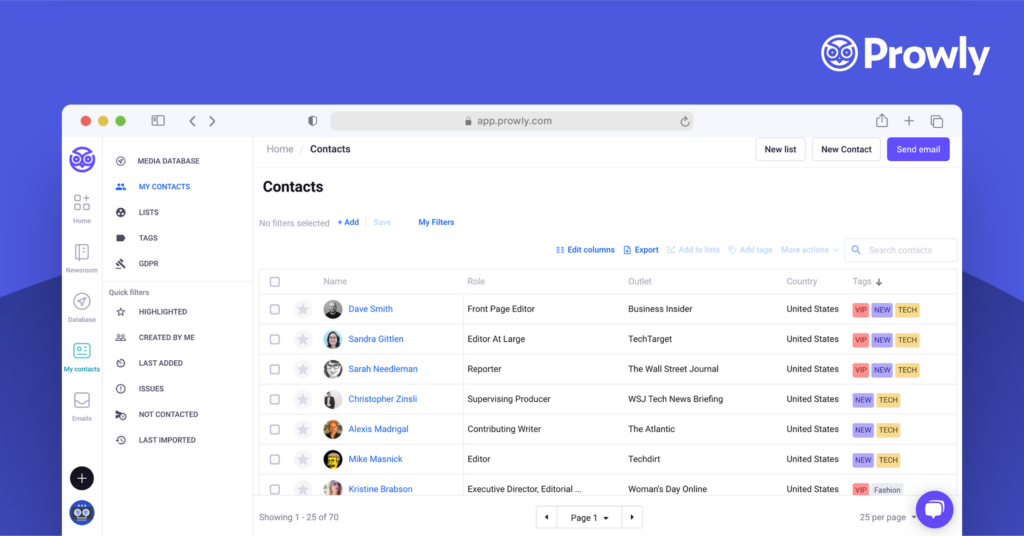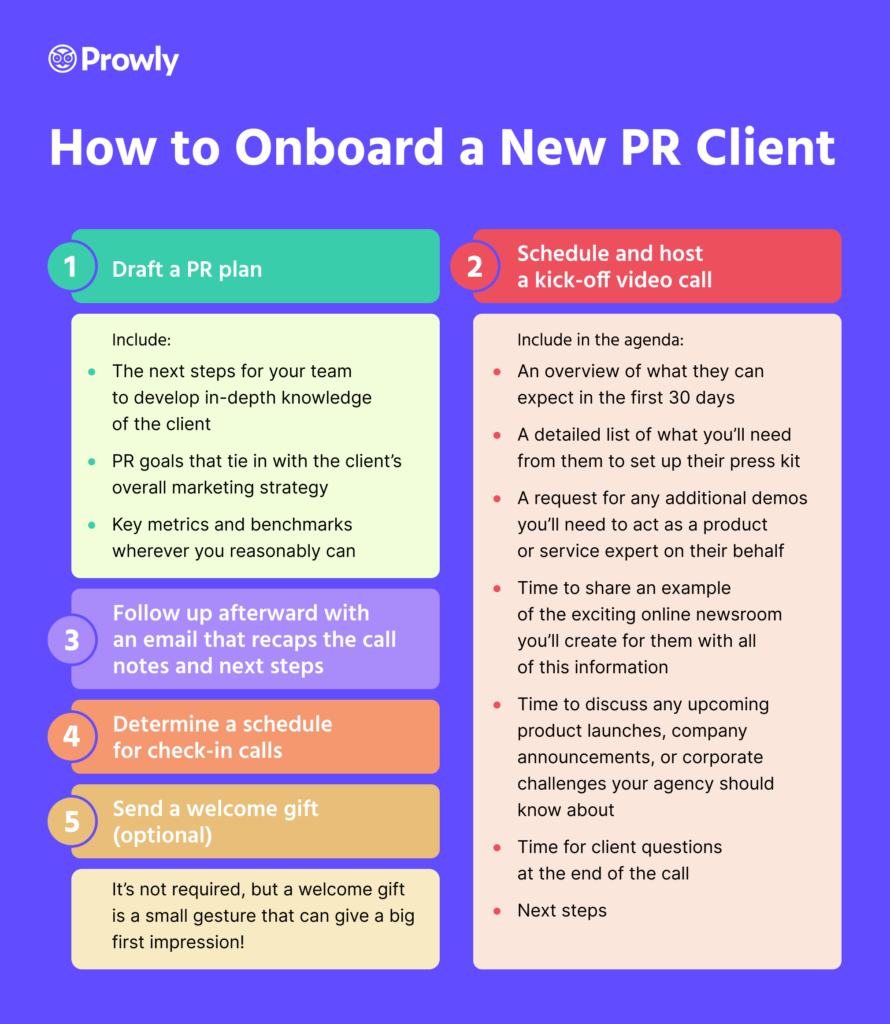Signing on a new client is the result of significant work. You spent hours discovering the client’s PR needs, presenting your agency’s benefits, talking the client though their concerns, and sharing your agency’s measurable value to their overall PR & marketing strategy.
But once they’ve signed (success!), the real work has only just begun. Now is the time to walk them through your agency’s PR client onboarding process. This is where you’ll build excitement and reinforce to the client that they made the best choice with your agency and are in excellent PR hands.
If you’re thinking to yourself, “Um, I don’t really have a client onboarding process in place”, there’s no need to fret. In this post, you’ll learn some of the best practices for PR client onboarding in a useful checklist you can easily follow step-by-step.
Begin to use it with your next new client, and before you know it, you and your team will be in the habit of a professional, repeatable client onboarding process. Now let’s get to work giving that new client a big welcome!
3 goals for PR client onboarding
When onboarding a new PR client, there are a number of goals to keep in mind. These will ensure you set the tone for this important—and hopefully long-term—client and agency relationship. Here are 3 of them you won’t want to overlook.
1. Establish your role as the PR lead. You want to convince your new client that they can trust you to take the lead. You will take the PR piece off their ever-growing PR & marketing plate and are set to manage the PR strategy and lock down results that tie into their bigger company goals. Let the client know you’re available to answer any questions they have about how PR works, and that you’re happy to provide any client education they need. This all ties in to your next goal:
2. Build trust. The earlier you establish trust with the client, the easier your job will be. There’s no need to explain your day-to-day PR tasks when they know you’ll deliver and report on key results regularly. It’s a big win for you when there’s less time focused on reassuring them and more time focused on media outreach and getting terrific press mentions.
3. Set clear expectations. You’ll want to remind the client that PR is a marathon, not a sprint, and that there will be investment time spent upfront to get the ball rolling. The first months will be focused on crafting press materials, creating story angles, and building a media list across traditional, social, radio/TV, and online outlets. Point out that the key to a successful strategy will be consistent media outreach and conversations, and leveraging every press mention across their marketing platforms.
Wherever possible, PR client onboarding should include clear PR goals that can later be touched back on. For example, the goal of monthly outreach to the top 25 media outlets you’ve highlighted on their wish list.
How to onboard a new PR client
The client onboarding process takes just a few steps, but they’re important ones. To simplify the process for you and make it a repeatable habit, we’ve created this checklist just for you.
1. Draft your PR plan
In your PR proposal, you offered some insights into how your agency could approach the clients’ PR goals. Now that you’re officially under retainer, consider what you’ll need to quickly become a media expert on the client product or service, and make a list.
Will you need an in-depth product demo from someone on their sales team? Will you require a tour of their factory to learn what goes behind their product’s craftsmanship?
Most importantly, this is where you tie your PR efforts into the client’s general PR & marketing plan. Reiterate the marketing goals they shared with you, and share how your agency’s PR efforts will support each goal.
For example, if they’re launching a new product next quarter, explain how you’ll be prepping this quarter with the development of the product’s press materials, media lists, and outreach plan (something you can manage easily with the help of PR automation software like Prowly).

Get specific about the key metrics and benchmarks your team will be working towards, based on what you learned from the client during the proposal phase.
- Is their goal to increase visibility of their CEO? Set a goal for the number of business features and podcasts you will send detailed pitches to.
- Do they want to focus on the announcement of a new global sustainability initiative? Set a goal for the number of press releases, social media posts and website backlinks you want to build out across the internet.
If the client’s goals aren’t crystal clear to you yet, make sure they are on the agenda for the next step.
To recap, include in your PR plan:
☑ The next steps for your team to develop in-depth knowledge of the client product or service, like a full sales demo or factory walk-through
☑ PR goals that tie in distinctly with the client’s overall marketing strategy
☑ Key metrics and benchmarks wherever you reasonably can
2. Schedule and host a kick-off video call
Here is where you establish your lead role, as we mentioned in the goals above. Create and distribute the agenda in advance, and send any questions your team plans to ask on the call. Get your team ready to walk through your PR strategy draft with the client.
While it may be tempting to schedule this over the phone, a face-to-face video call with your client and your team is extremely important during this relationship-building part of the client onboarding process.
Your client may be new to the inner workings of a PR agency, so take time to explain to them the “behind the scenes” of your work. Start with introductions that explain each team member’s background, expertise, and agency role so that your new client feels personally connected with each of them.
If you’re like most PR agencies, the client will walk away feeling like they’ve retained a PR strategist, copywriter, social media expert, and media pitch pro all in one package!
Include in the agenda:
☑ An overview of what they can expect in the first 30 days
☑ A detailed list of what you’ll need from them to set up their press kit
☑ A request for any additional demos you’ll need to act as a product or service expert on their behalf
☑ Time to share an example of the exciting online newsroom you’ll create for them with all of this information, and how you can easily collaborate on press releases there together (Again, PR software like Prowly makes this a breeze!)
☑ Time to discuss any upcoming product launches, company announcements, or corporate challenges your agency should know about. It’s very important that the client sees your agency as a part of their internal team so that your PR efforts don’t run into any surprises along the way, like product launch delays or a company lawsuit
☑ Time for client questions at the end of the call
☑ Next steps. On this call, you don’t need to set the stage for months out. In fact, it’s better to focus on the first month and the tasks you’ll need to complete together
☑ Wrap-up with the 3 or 4 steps they can expect next
3. Kick-off call follow-up
Don’t forget to follow up afterward with an email that recaps the call notes and next steps. Everyone appreciates a good follow-up recap with clearly stated assignments.
4. Determine a schedule for check-in calls
This need varies by client, but a good rule of thumb is to start with weekly calls in the first month as you prepare the client’s online newsroom, press photos, and media training.
After that, monthly calls are common so that you and your team have time to make progress and bring results to each call. Once the regular check-in schedule is agreed upon, follow up immediately with calendar invites to ensure you’re on their calendar.
5. Send a welcome gift (optional)
It’s not required, but a welcome gift is a small gesture that can give a big first impression. The gift can be as simple as a box of gourmet sweets or a bouquet of flowers for the client’s office, with a note thanking them for their trust in your agency and your excitement about working with them.
Some PR agencies like to send a gift that will prove useful to the client for upcoming PR opportunities, like a podcast microphone or portable desk ring light.

With this upfront investment in a PR client onboarding process, you’ll reap big rewards. The client will feel relieved to know you’re at the PR wheel leading an agency team focused on getting them PR results, and your team will feel content knowing the client trusts them to lead their new and exciting PR journey.
You’ll be well on your way to a solid, long-term relationship, and hopefully a few future referrals from them down the road!
Cover photo by Jason Goodman

